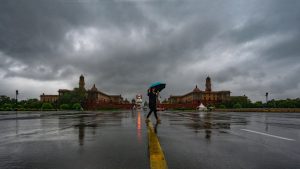Thursday, July 31, 2025
Severe weather conditions are causing massive disruptions across the United States, with New York City, Baltimore, Albany, Chicago, Hartford, Houston, and Philadelphia all facing significant travel chaos due to intense thunderstorms and heavy rainfall. The storm systems are expected to bring flash flooding, strong winds, and dangerous conditions that could severely impact travel plans throughout these cities.
In New York City, up to 5 inches of rain may fall within hours, creating hazardous road conditions and delays in the subway system. Philadelphia and Baltimore are also under a flood watch, as heavy rain could overwhelm drainage systems and flood streets. Meanwhile, Chicago and Albany are bracing for scattered thunderstorms and the potential for localized flooding. Houston, already experiencing extreme heat, is now facing sporadic thunderstorms that may provide temporary relief but also cause disruptions.
Advertisement
Advertisement
As the storm system intensifies, travelers are advised to stay informed about their routes and prepare for potential delays. The National Weather Service has issued warnings and advisories for all affected areas, urging people to stay safe by avoiding unnecessary travel and taking precautions against flash flooding and severe thunderstorms. For those planning to travel in these cities, the situation could worsen quickly, so staying updated on the latest weather information is critical.
As of July 31, 2025, various cities across the United States are bracing for severe weather, including thunderstorms, heavy rain, and flash floods. The National Weather Service has issued flood watches and warnings, especially for the Northeast, Mid-Atlantic, and parts of the Midwest. With some regions expecting up to 5 inches of rain in just a few hours, residents are being urged to take precautions and stay informed. Here’s an in-depth look at which U.S. cities are affected and how to prepare for these dangerous weather conditions.
Severe thunderstorms and flash flooding are expected to hit New York City, with up to 5 inches of rain forecast in just a few hours. The National Weather Service has issued a flood watch for the region, warning of potentially dangerous conditions starting Thursday afternoon. As the storm system intensifies, the city’s emergency management has urged residents to prepare and avoid unnecessary travel. This sudden deluge could cause serious disruptions, especially during the evening commute. New Yorkers are advised to stay alert and be ready to take action if the situation worsens.
Severe Flooding Expected as Rainfall Intensifies
On Thursday, July 31, 2025, New York City is bracing for heavy rainfall, with up to 5 inches of rain expected in some areas. The National Weather Service has issued a flood watch for the region, extending through Friday afternoon. This storm system is bringing intense rainfall over a short period, which could quickly overwhelm the city’s drainage system and flood streets. Flash flooding is one of the most dangerous weather conditions in the city because it happens rapidly, leaving little time for residents to react. The heaviest rainfall is expected between Thursday afternoon and Friday morning, with 1.5 to 3 inches of rain predicted for the city.
New York City Emergency Management on High Alert
As the storm approaches, New York City Emergency Management Commissioner Zach Iscol warned that “intense rainfall rates” could cause dangerous conditions. The city’s emergency management teams are on high alert, fully mobilized to respond to the potential flooding. People living in flood-prone areas, particularly those in basement apartments, are urged to stay alert and prepare for possible evacuation. Mayor Eric Adams also emphasized the risk of flash flooding, stating, “Flash flooding is one of the most dangerous hazards we face in New York City because it can happen quickly and without warning.” With this in mind, the city has urged residents to have an emergency plan in place.
Residents Warned to Prepare for Flash Flooding
Flash flooding is a significant concern for New York City as this storm develops. It can strike without warning, creating hazardous conditions in a matter of minutes. For many residents, particularly in low-lying areas or places prone to flooding, the threat of fast-moving water is very real. Emergency management teams have been preparing for the worst, including potential subway disruptions and closed roadways. The flash flooding risks could be especially severe during the evening commute when large numbers of people are traveling home. The city’s preparedness efforts aim to minimize damage and ensure public safety.
Storm Could Impact the Evening Commute and Travel Plans
New Yorkers can expect travel disruptions throughout the storm, especially during the evening commute on Thursday. Heavy rain and flash flooding will create hazardous conditions, leading to potential delays on the roads and at transit stations. Public transportation systems, including the subway, are at risk of flooding, which could cause delays or cancellations. The city is advising people to stay home if possible, avoid driving in flooded areas, and monitor travel advisories. Those who must travel should be prepared for slow-moving traffic and detours. Emergency alerts are being sent to keep everyone informed of rapidly changing conditions.
Storm Preparedness and What New Yorkers Can Do
As the storm moves closer, New York City residents are urged to take a few basic steps to stay safe. First and foremost, avoid unnecessary travel during the peak of the storm, especially in flood-prone areas. Basement apartments and low-lying buildings should be evacuated if the flooding intensifies. Residents should have emergency supplies ready, including flashlights, batteries, and waterproof clothing. Emergency services have highlighted the importance of staying informed through reliable sources like the National Weather Service and local authorities. Community organizations and neighborhood watch programs can also provide valuable support during the storm.
Flood Watch in Effect Through Friday Afternoon
The National Weather Service’s flood watch will remain in effect until Friday afternoon, allowing time for additional rainfall to accumulate and for flash flood risks to remain high. Forecasters are predicting a steady stream of rain throughout Thursday and into Friday morning, with the heaviest rain expected to fall over the city in just a few hours. For those with travel plans, it’s important to stay updated on the latest weather reports and possible road closures. City officials have mobilized emergency response teams, but New Yorkers need to be proactive in their own preparedness to ensure their safety during this intense weather event.
Emergency Services Prepared to Respond Quickly
Emergency response teams in New York City have been activated to handle the flash flooding and other storm-related emergencies. These teams are prepared to help residents evacuate flood zones, provide shelter if needed, and ensure that emergency services are available 24/7. The city has also ramped up efforts to maintain public health and safety during the storm, including setting up temporary evacuation shelters for vulnerable populations. Flood barriers and sandbags are being distributed to help protect critical infrastructure. However, residents are still advised to remain vigilant and follow instructions from local authorities.
Stay Safe and Be Prepared for Flash Flooding in New York City
As New York City braces for severe weather, residents must remain vigilant and prepared for potential flash flooding. With up to 5 inches of rain forecast in just a few hours, the city faces a significant storm threat. The National Weather Service has issued a flood watch, urging residents to stay alert and avoid unnecessary travel. Emergency teams are mobilized and prepared to handle the impact of the storm, but individual preparedness is key. By staying informed, having an emergency plan, and taking precautions, New Yorkers can reduce the risks associated with this dangerous weather event.
New York City: Flash Flooding Expected
New York City is one of the major cities under threat of severe flooding. The National Weather Service issued a flood watch for the city, warning residents of possible rainfall rates of up to 5 inches in just a few hours. Heavy rain is expected to begin Thursday afternoon and continue into Friday morning. The NWS has specifically highlighted flash flooding as a significant concern, as it can occur very quickly and without much warning. Areas like Times Square and the subway system are particularly vulnerable to flooding, as they tend to collect water rapidly.
The city’s emergency management teams have advised all residents to avoid travel if possible. People living in basement apartments or areas that are prone to flooding should be prepared to evacuate if conditions worsen. During the evening commute, travel delays are expected, and streets could quickly flood, leading to potential road closures and major disruptions to daily activities.
Philadelphia: Heavy Rain and Flooding Risks
In Philadelphia, the risk of flooding is also a major concern. With the potential for 2-5 inches of rain in some areas, residents are being warned of severe flash flooding. The forecast calls for heavy rainfall rates that could overwhelm the city’s storm drainage systems. Areas with poor drainage will likely experience street flooding, which could make travel difficult. The NWS has advised people to stay updated on weather reports and to prepare for possible road closures and delays in public transportation.
It’s important for residents in flood-prone areas to have an emergency plan in place. With the forecasted rainfall, there could be an increased risk of flash flooding in low-lying areas, causing significant disruption to daily life. People who live near rivers, streams, or creeks should remain especially vigilant, as these areas are often the first to flood during storms.
Washington, D.C.: Potential for Dangerous Conditions
The forecast for Washington, D.C. includes the possibility of 3 inches of rain per hour, making flash flooding a significant threat. The NWS has issued a flood watch for the city, expecting the heaviest rainfall between Thursday afternoon and Friday morning. With rain falling at such a fast rate, the city could experience serious flooding, particularly in urban areas where drainage systems may struggle to keep up. The combination of heavy rain and strong winds could also lead to damaging thunderstorms, making the risk even higher.
Mayor Eric Adams of New York City highlighted that flash flooding in urban areas can happen suddenly and without warning, making it especially dangerous for commuters. Emergency services in Washington, D.C. are ready to respond quickly, but the public is urged to stay alert and take extra precautions. Avoiding unnecessary travel and ensuring that flood protection measures are in place will be key to staying safe.
Baltimore: Monitoring Rising Flood Risks
Baltimore is facing similar weather conditions, with heavy rain and a heightened risk of flash flooding. The NWS has warned that rainfall could reach 2-4 inches, particularly in the late afternoon and evening hours. The city’s public transportation system may experience delays, and several streets in downtown Baltimore could flood due to poor drainage and high water levels.
Residents in areas prone to flooding should take early precautions, such as moving vehicles away from flood-prone zones and securing important belongings. Those living near rivers and streams should also prepare for possible evacuations if the water level rises quickly. Baltimore’s emergency management team is closely monitoring the storm, and residents are encouraged to follow updates for changing conditions.
Hartford and Albany: Flash Flood Warnings Issued
Hartford, CT, and Albany, NY, are also under flash flood warnings, with both cities expected to experience significant rainfall. In Hartford, the NWS predicts 1-2 inches of rain with localized areas receiving up to 4 inches, creating a high risk of flooding in the city’s downtown and other low-lying areas. Similarly, in Albany, rainfall of up to 3 inches is expected, with the possibility of even higher totals in some parts of the city. Both cities have been warned to expect potential street flooding and disruptions to public services.
Emergency management officials in these areas have encouraged residents to avoid driving and to seek higher ground if flooding occurs. The combination of rain and strong winds could result in tree falls and downed power lines, so safety measures should be in place for anyone in flood-prone locations.
Chicago: Hazy Conditions with a Chance of Thunderstorms
While Chicago may not be experiencing the same level of severe flooding, the city is facing hazy conditions due to wildfire smoke. The NWS has issued an air quality alert, warning residents to limit outdoor activities due to the presence of harmful particles in the air. While the storm isn’t expected to cause significant rain or flooding in Chicago, the combination of heat, haze, and occasional thunderstorms could cause discomfort and health risks for some residents. It’s important for individuals, especially those with respiratory conditions, to stay indoors during these times.
Other Cities Under Flood Watch
Several other cities across the U.S. are also dealing with flash flood warnings and heavy rain. These include Miami, Houston, and Phoenix, each experiencing unique weather conditions.
In Miami, afternoon thunderstorms are expected, with the NWS predicting heavy rainfall in the form of localized storms. Houston is under a heat advisory, but scattered thunderstorms could bring temporary relief to the area. Phoenix, on the other hand, is under an extreme heat warning, with temperatures expected to exceed 110°F for the next few days. Although Phoenix is not facing rain, residents should be aware of the extreme heat and stay hydrated.
Safety Tips for Flash Floods
When severe weather strikes, it’s important to stay informed and prepared. Here are a few essential tips:
- Avoid travel: Stay home if possible, especially during heavy rain or thunderstorms.
- Monitor weather updates: Follow local weather reports and government warnings.
- Move to higher ground: If you live in a flood-prone area, move to higher ground immediately.
- Stay away from floodwaters: Never attempt to drive through flooded streets, and avoid walking in fast-moving water.
Conclusion: Be Prepared for Sudden Weather Changes
The weather in many U.S. cities on July 31, 2025, is unpredictable and dangerous. With up to 5 inches of rain expected in just a few hours, the risk of flash flooding is very real. Cities like New York, Philadelphia, and Washington, D.C. are on high alert, urging residents to stay prepared and take precautions. Understanding the risks and following safety guidelines can help prevent accidents and ensure safety during severe weather events. Stay updated on forecasts, and be ready to act quickly if conditions worsen.
Advertisement
Advertisement
Tags: flash flooding, New York City, severe thunderstorm, travel chaos, Weather Disruptions
I want to receive travel news and trade event update from Travel And Tour World. I have read Travel And Tour World’sPrivacy Notice.
Saturday, August 2, 2025
Saturday, August 2, 2025
Saturday, August 2, 2025
Saturday, August 2, 2025
Saturday, August 2, 2025
Saturday, August 2, 2025
Saturday, August 2, 2025
Saturday, August 2, 2025




